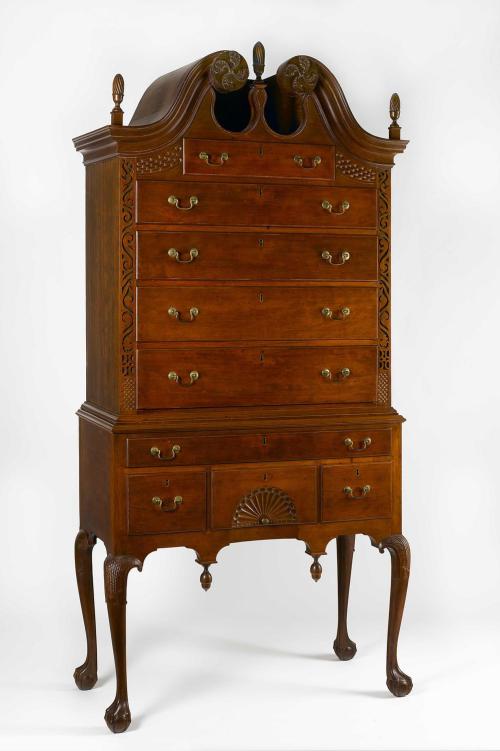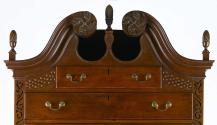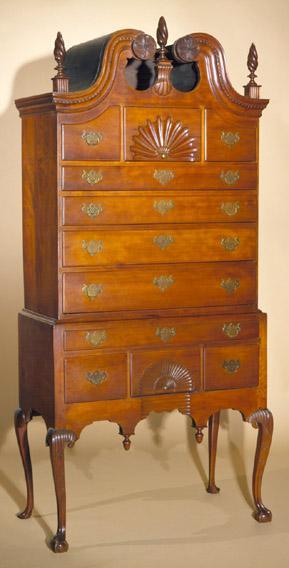High Chest
Original OwnerOriginally owned by
Hannah Grant
(American, 1749 - 1830)
Original OwnerOriginally owned by
Honorable Stephen Mix Mitchell
(American, 1743 - 1835)
Furniture MakerMade by
Unknown
Dateabout 1769
MediumCherry primary wood, tulip poplar and oak secondary wood, brass hardware
DimensionsPrimary Dimensions (overall height x width x depth): 85 x 42 1/2 x 20 5/8in. (215.9 x 108 x 52.4cm)
ClassificationsFurniture
Credit LineBequest of Lucy Pratt Mitchell
Object number1941.1.4
DescriptionCherry high chest with a swan's neck pediment in the Chippendale, or rococo, style. The pediment has a conforming roof, or bonnet top, which is open at the center. Each upper end of the pediment molding terminates in a pinwheel rosette. At the top of the high chest there are three three finials (replaced), each consisting of an abstract twisted flame over a small urn. The center finial sits on top of a curved plinth; the side finials sit on small rectangular plinths. The drawer arrangement of the upper case consists of a relatively narrow top drawer over four full-width, graduated drawers. The top drawer is flanked by a panel of carved wood, with the texture of basketweave, which conforms to the shape of the pediment. Each of the front corners of the top case have a fretted pilaster, or pierced flat column. The fretwork pattern consists of S-curves and C-curves, scrolls, and geometric spaces. The bottom of each pilaster is decorated with a carved fishscale pattern. The pilasters are pierced to reveal a narrow, removeable panel behind it. These panels are painted green on one side and painted red (now faded) on the other. The top case fits inside the mid-molding of the lower case. The lower case drawer arrangement consists of one full-width drawer over three equal-height drawers in a line; the lower center drawer has a carved shell on the front and is wider than the side drawers. The front skirt consists of three flathead arches separated by two hanging drop pendants (replaced). The middle of the skirt is recessed to match the curve of the carved shell in the drawer above. The side skirts each have one long flathead arch. The cabriole legs have carved knees and elongated claw-and-ball feet. Hardware on each upper case drawer and on the top lower case drawer consists of a brass-lined keyhole in the center flanked by a ring-and-bail pull. The shell-carved drawer has a brass-lined keyhole in the top center, and a brass knob at the bottom center of the shell. Each side drawer has a single ring-and-bail pull below a brass-lined keyhole. There are two working keys.
Condition: Repairs have been made to the backboard and right side of the lower case. The wood above the escutcheons on the top drawer and the fourth drawer in the upper case has been repaired. Strips of wood have been added to the bottom of some drawer sides. The surface has been cleaned and refinished. The finials, drop pendants, and hardware are replaced.
Design and Construction Details:
Carving. Each large, applied rosette consists of a four-lobed pinwheel; each pinwheel has six graduated half-circles carved inside. The carved shell on the lower center drawer consists of thirteen recessed rays; an arch of thirteen off-set lobes adjoins the upper end. Each carved knee consists of a fishscale, or snakeskin, panel flanked by two carved lines; there is a heart below the panel. The carved knee returns consist of a C-curve with a scroll at the upper end. The back of the knee on the rear legs is flush with the back of the leg post.
Case Construction. The back of the bonnet top is cut straight across the center; each interior side of the bonnet top has a vertical support. The back of the bonnet top extends down past the top of the upper case. The upper-case backboards are vertically oriented and are nailed into rabbets in the case sides. The basketweave decoration is carved on separate panels that are joined to the upper case. The painted panel behind the fretwork slides out of a slot in the top of the case, on the inside corner of each side finial. The mid-molding is formed of two sections. The top section consists of a molding strip that is nailed to the outside bottom edge of the front and sides of the upper case. The front and sides of the lower case each have a strip of wood applied lengthwise to the top edge. These strips form the supports on which the upper case rests; the outside edges of these strips form the bottom section of midmolding. The lower case has no top. The lower case is formed with mortise-and-tenon construction. The interior construction of the high chest has highly finished surfaces.
Drawer Construction. The upper case drawer dividers are tenoned into the case sides and have a notch at each front corner to accommodate the pilaster. These drawer dividers are 6 1/8 inches deep. The drawer runners are each tenoned into the drawer divider on one end and into a piece of wood that is tenoned into the back of the case sides on the other end. The drawer guides are nailed into the drawer runners. The lower case drawer dividers and vertical partitions are tenoned into the case sides. The top drawer has a medial drawer runner and a drawer runner at each side. The drawer runners for the top drawer are dovetailed to the drawer divider; the drawer runners for the lower drawers are dovetailed into the skirt. All drawer runners at the sides of the case are nailed to the leg posts in the back. The center drawer runners are tenoned into the backboard. All the drawer fronts are lip-molded with ovolo, or thumbnail, molding on all four sides. The drawer sides are rounded on top. The drawer bottoms fit into grooves in the front and sides of each drawer and are nailed at the back. The dovetail pins extend past the back of the drawers to form a 1/8-inch stop; the dovetails in the back corners of each drawer are reversed. The center drawer in the lower case has an extra block of wood on the lower interior surface, probably to accommodate the hardware.
Please see attached essay by Dr. Thomas P. Kugelman for more information about this piece.
Condition: Repairs have been made to the backboard and right side of the lower case. The wood above the escutcheons on the top drawer and the fourth drawer in the upper case has been repaired. Strips of wood have been added to the bottom of some drawer sides. The surface has been cleaned and refinished. The finials, drop pendants, and hardware are replaced.
Design and Construction Details:
Carving. Each large, applied rosette consists of a four-lobed pinwheel; each pinwheel has six graduated half-circles carved inside. The carved shell on the lower center drawer consists of thirteen recessed rays; an arch of thirteen off-set lobes adjoins the upper end. Each carved knee consists of a fishscale, or snakeskin, panel flanked by two carved lines; there is a heart below the panel. The carved knee returns consist of a C-curve with a scroll at the upper end. The back of the knee on the rear legs is flush with the back of the leg post.
Case Construction. The back of the bonnet top is cut straight across the center; each interior side of the bonnet top has a vertical support. The back of the bonnet top extends down past the top of the upper case. The upper-case backboards are vertically oriented and are nailed into rabbets in the case sides. The basketweave decoration is carved on separate panels that are joined to the upper case. The painted panel behind the fretwork slides out of a slot in the top of the case, on the inside corner of each side finial. The mid-molding is formed of two sections. The top section consists of a molding strip that is nailed to the outside bottom edge of the front and sides of the upper case. The front and sides of the lower case each have a strip of wood applied lengthwise to the top edge. These strips form the supports on which the upper case rests; the outside edges of these strips form the bottom section of midmolding. The lower case has no top. The lower case is formed with mortise-and-tenon construction. The interior construction of the high chest has highly finished surfaces.
Drawer Construction. The upper case drawer dividers are tenoned into the case sides and have a notch at each front corner to accommodate the pilaster. These drawer dividers are 6 1/8 inches deep. The drawer runners are each tenoned into the drawer divider on one end and into a piece of wood that is tenoned into the back of the case sides on the other end. The drawer guides are nailed into the drawer runners. The lower case drawer dividers and vertical partitions are tenoned into the case sides. The top drawer has a medial drawer runner and a drawer runner at each side. The drawer runners for the top drawer are dovetailed to the drawer divider; the drawer runners for the lower drawers are dovetailed into the skirt. All drawer runners at the sides of the case are nailed to the leg posts in the back. The center drawer runners are tenoned into the backboard. All the drawer fronts are lip-molded with ovolo, or thumbnail, molding on all four sides. The drawer sides are rounded on top. The drawer bottoms fit into grooves in the front and sides of each drawer and are nailed at the back. The dovetail pins extend past the back of the drawers to form a 1/8-inch stop; the dovetails in the back corners of each drawer are reversed. The center drawer in the lower case has an extra block of wood on the lower interior surface, probably to accommodate the hardware.
Please see attached essay by Dr. Thomas P. Kugelman for more information about this piece.
Status
Not on view


















